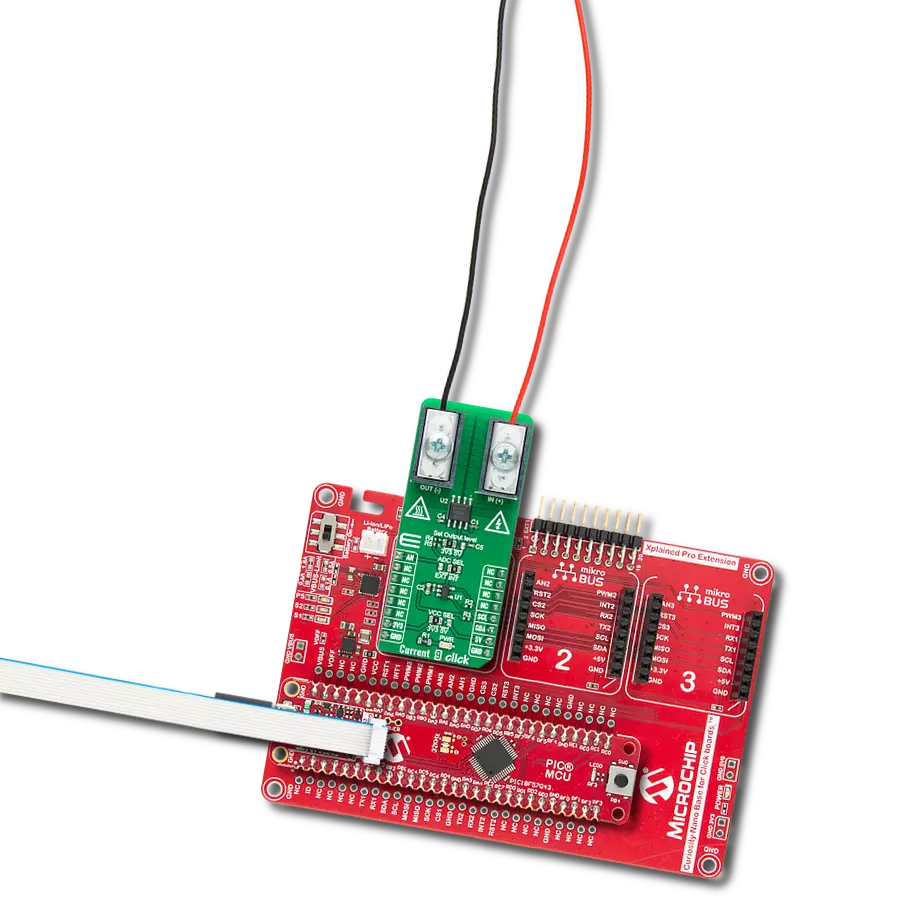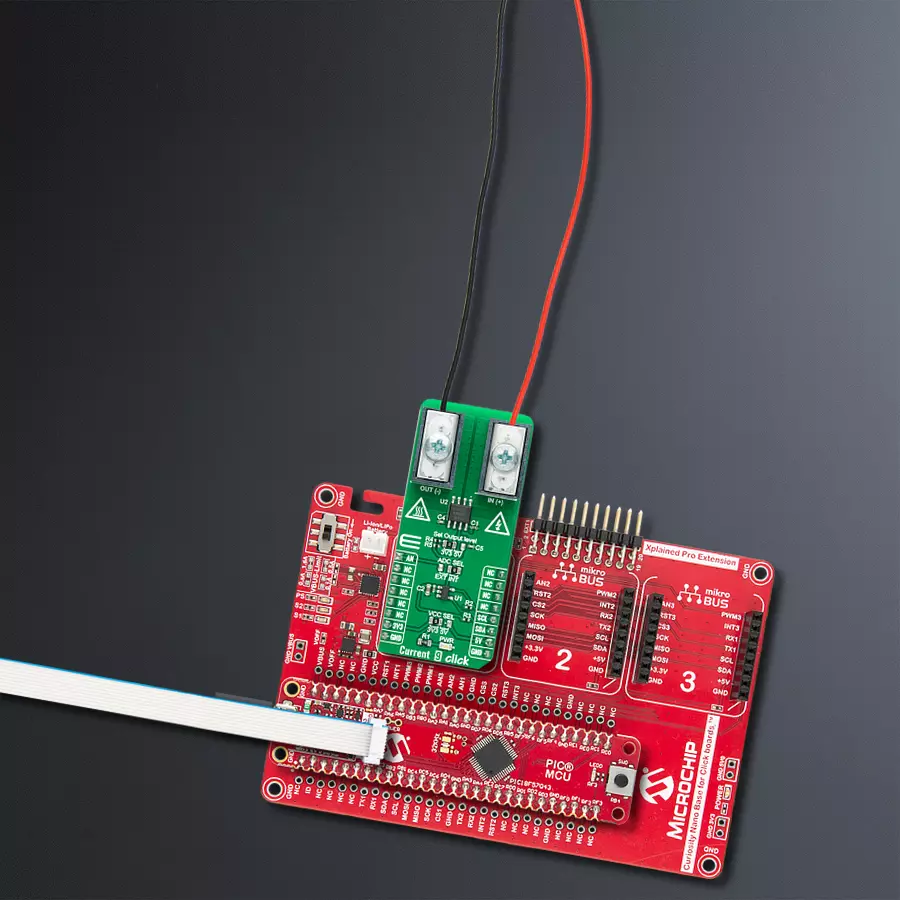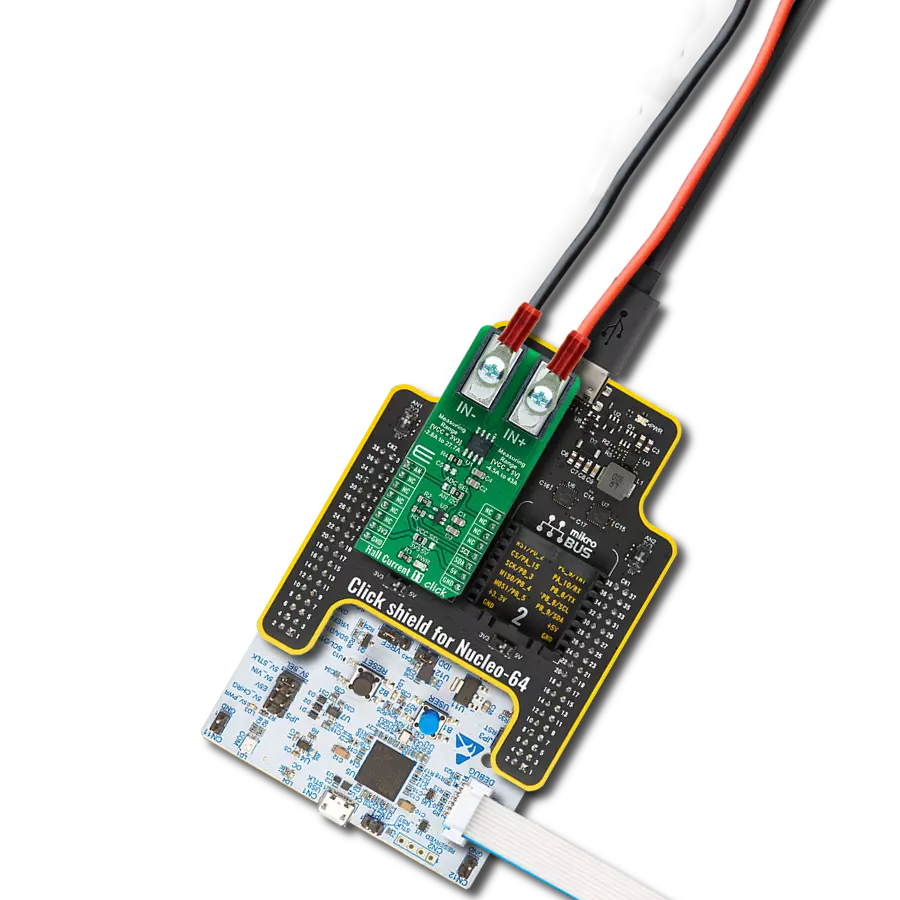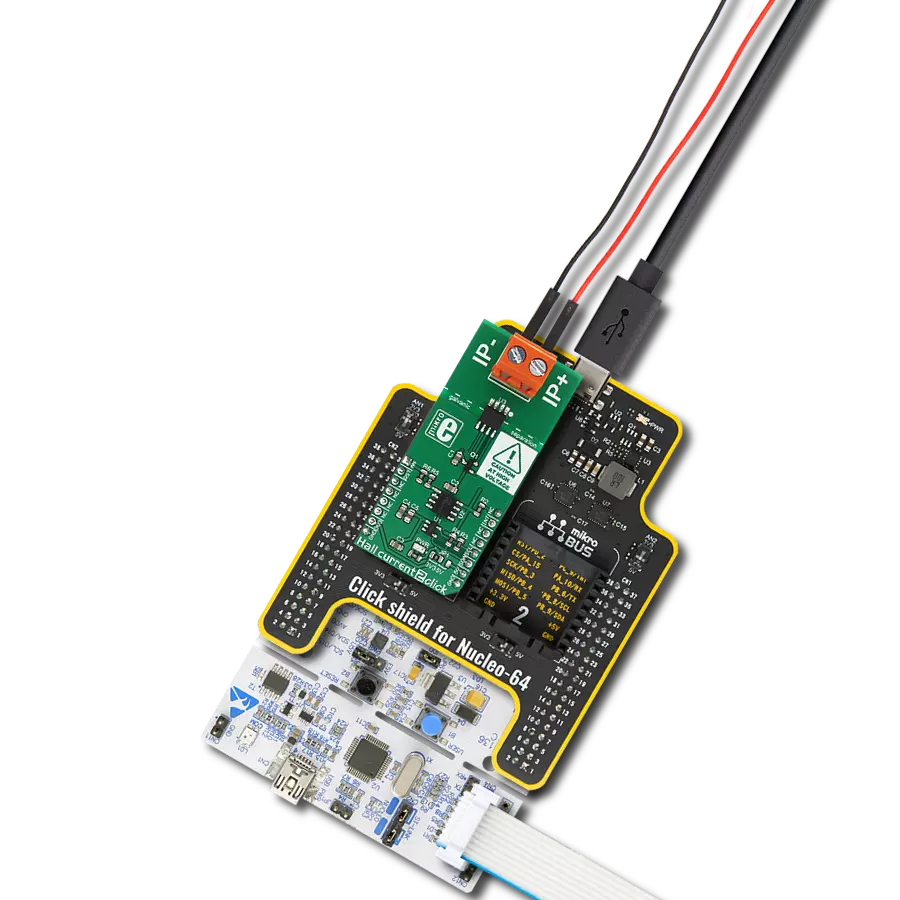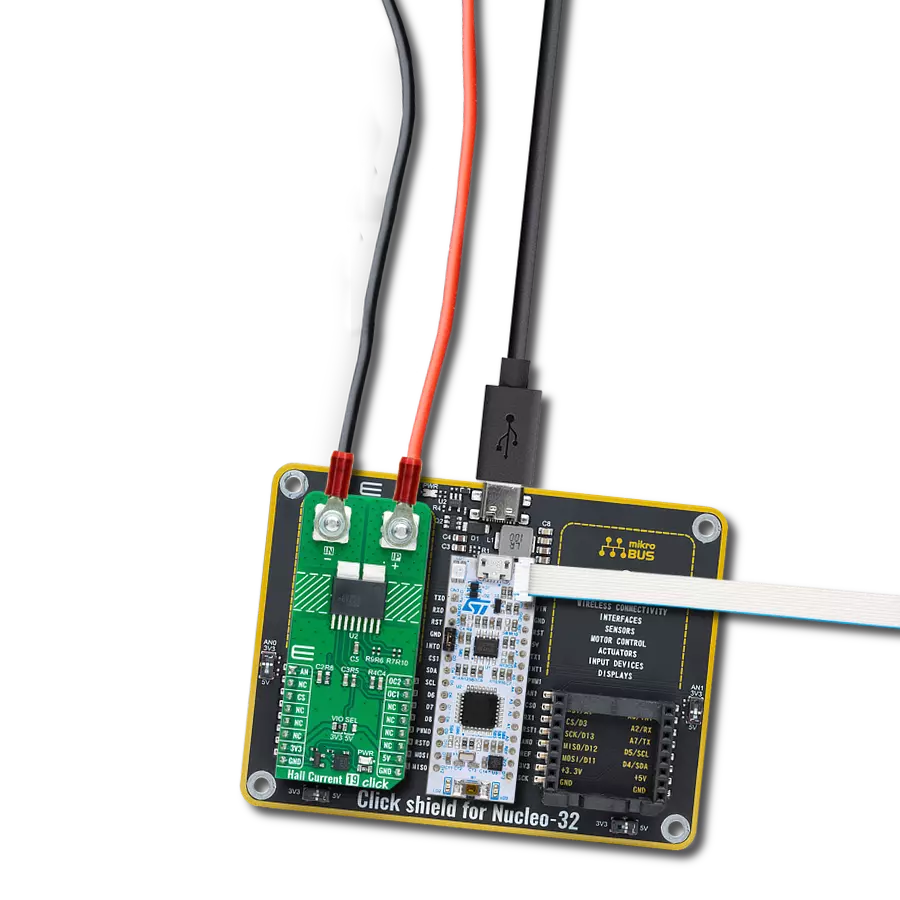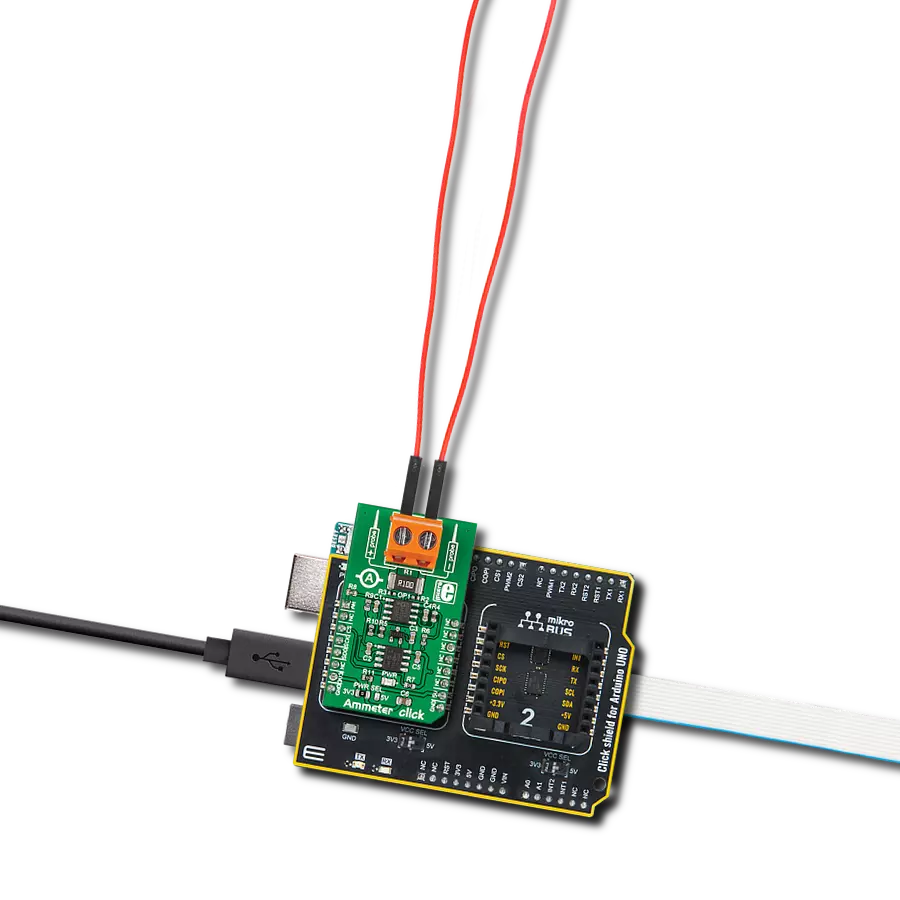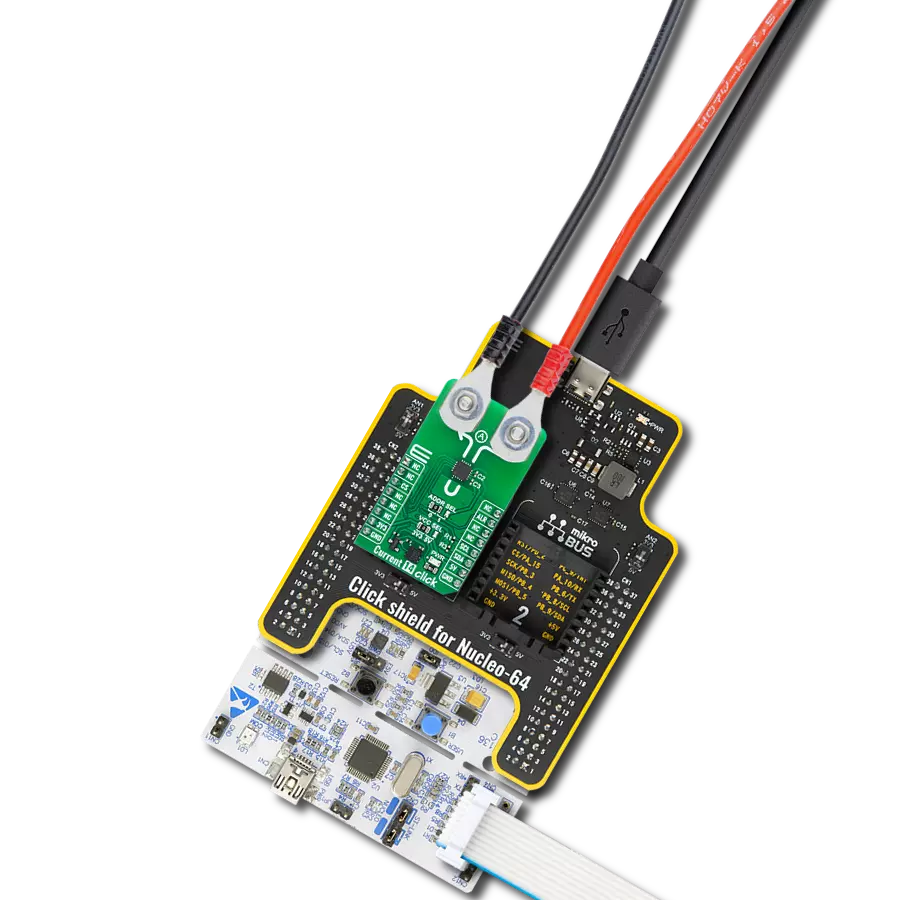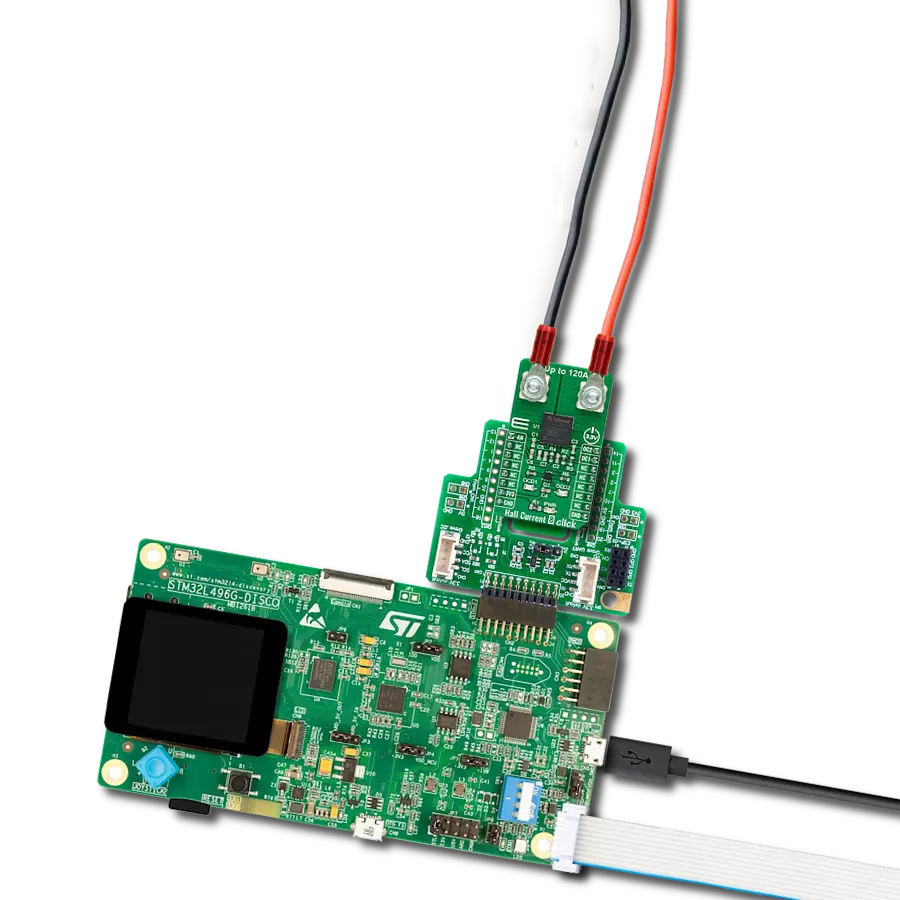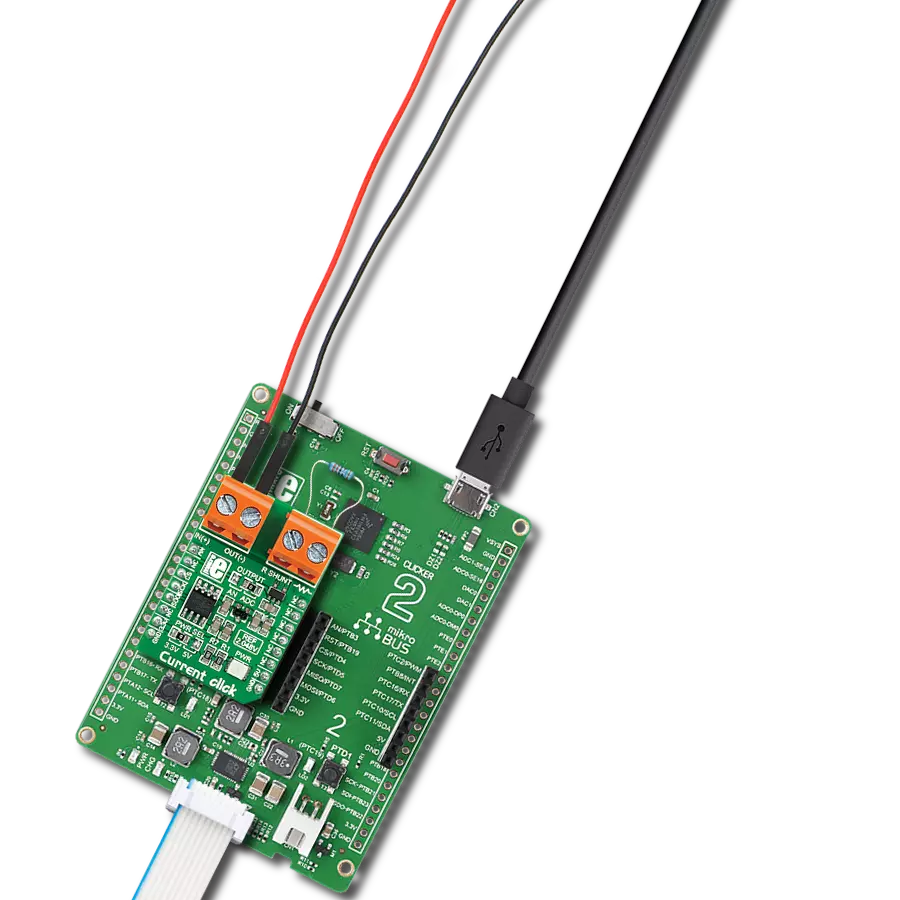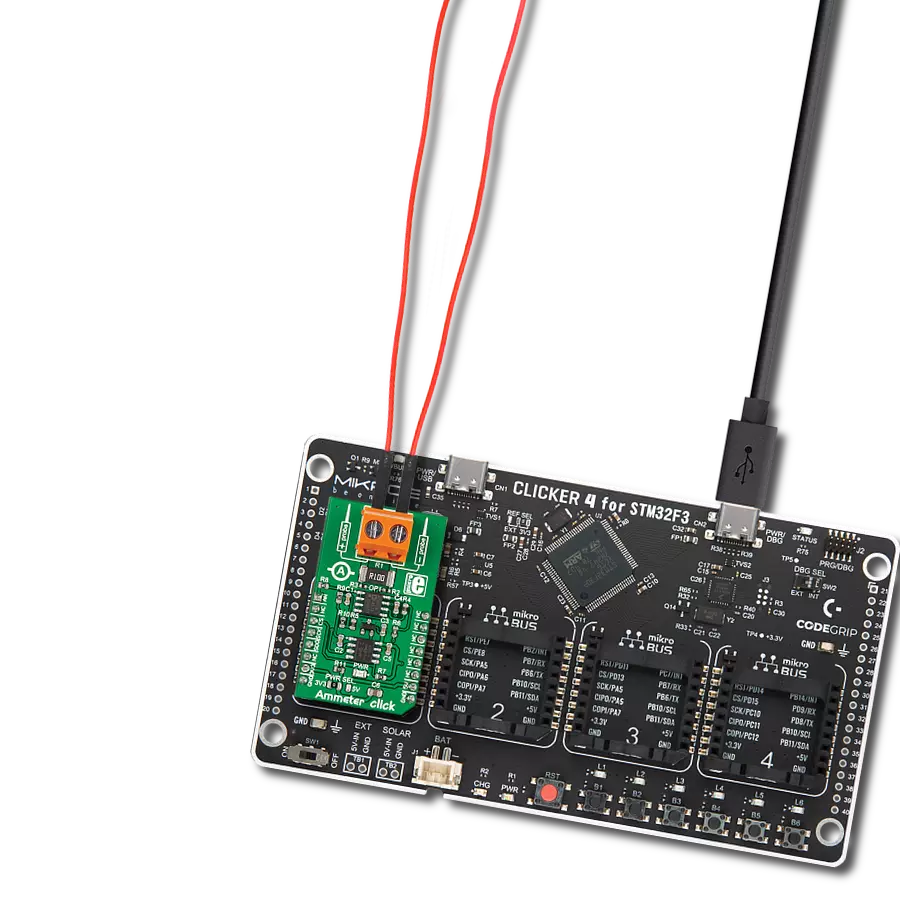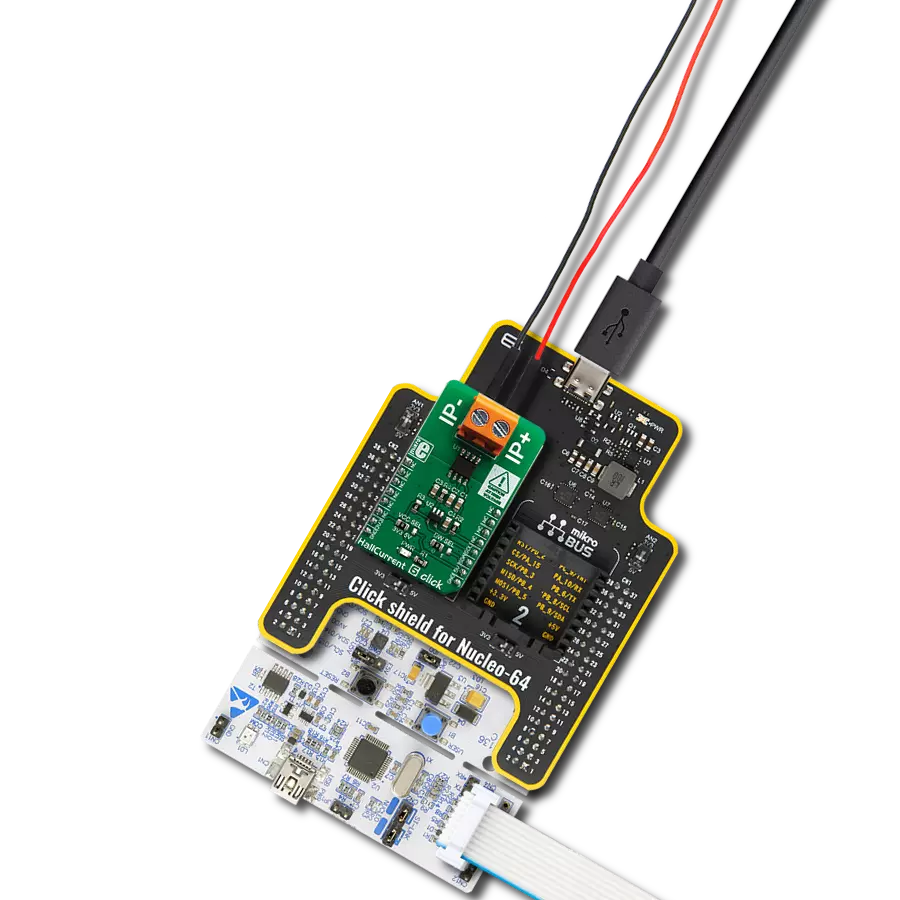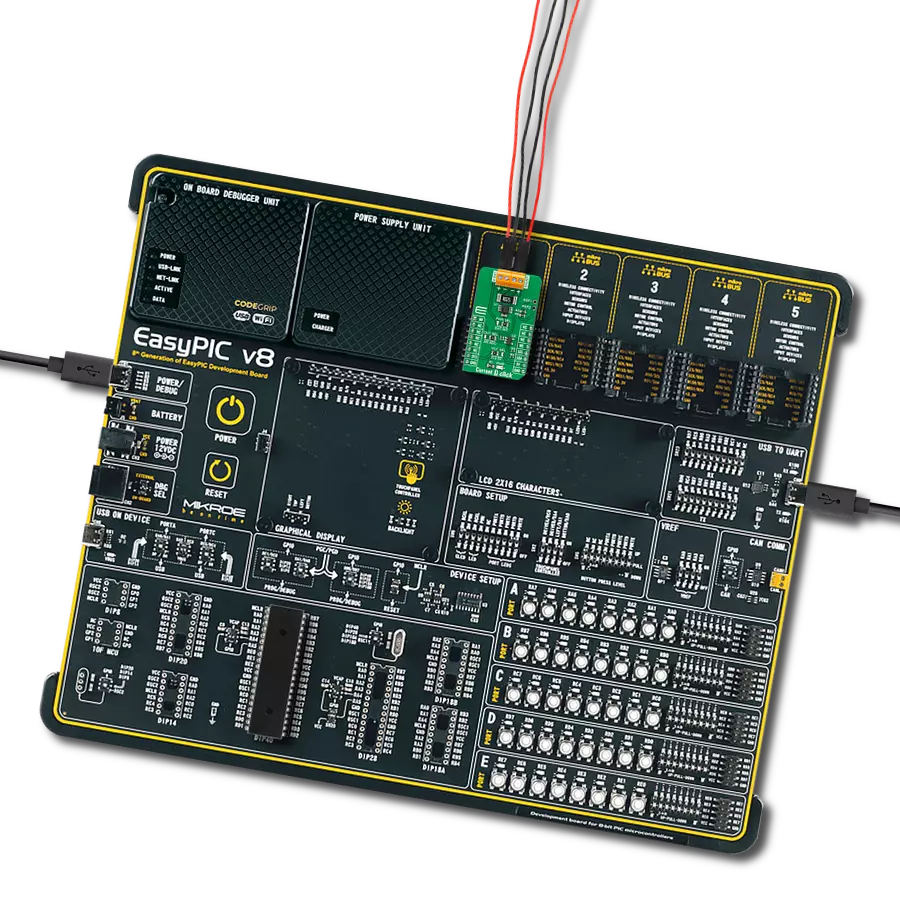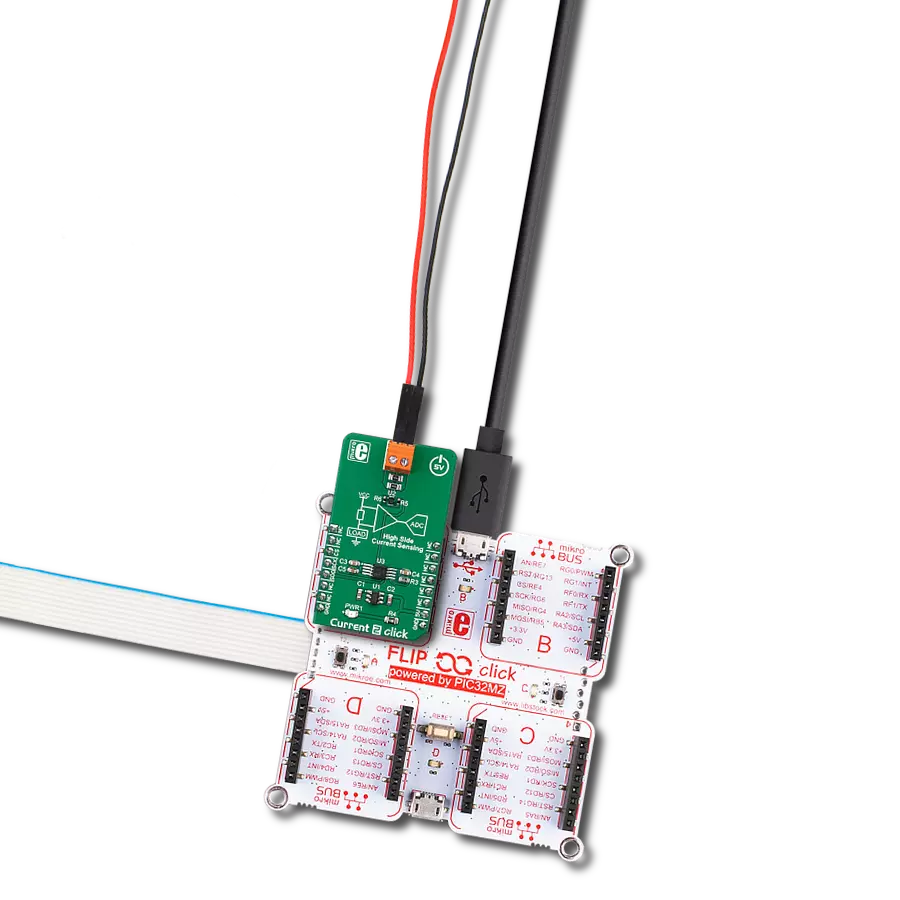Precise and accurate current sensing solution
A
A
Hardware Overview
How does it work?
Current 9 Click is based on the CT415-HSN830DR, an XtremeSense® TMR current sensor providing high-accuracy current measurements from Crocus Technology. The CT415-HSN830DR has an integrated current-carrying conductor (CCC) that handles the current from 0A up to 30A. It has high sensitivity and a wide dynamic range with excellent accuracy (low total output error), making it suitable for many consumer, enterprise, and industrial applications. When current flows through the CCC, the XtremeSense® TMR sensors inside the chip sense the field, generating a differential voltage signal that goes through the analog front-end to output a current measurement with less than ±1% full-scale total output error. The CT415-HSN830DR
is designed to enable a fast response time for the current measurement. In addition, the user can select the output voltage level of the sensor performed by the onboard SMD jumper by populating it to an appropriate position marked as 3V3 or 5V. Even with high bandwidth of 1MHz, the CT415-HSN830DR consumes minimal power. The output signal of the CT415-HSN830DR can be converted to a digital value using MCP3221, a successive approximation A/D converter with a 12-bit resolution from Microchip using a 2-wire I2C compatible interface, or can be sent directly to an analog pin of the mikroBUS™ socket labeled as AN. The selection can be made by an onboard SMD jumper labeled ADC SEL, placing it in an
appropriate position marked as EXT and INT. Also, this Click board™ should be connected in series with the load. Two onboard terminal connectors measure the current, one terminal block for the positive and the other for the negative current input. This Click board™ can operate with either 3.3V or 5V logic voltage levels selected via the VCC SEL jumper. This way, both 3.3V and 5V capable MCUs can use the communication lines properly. However, the Click board™ comes equipped with a library containing easy-to-use functions and an example code that can be used, as a reference, for further development.
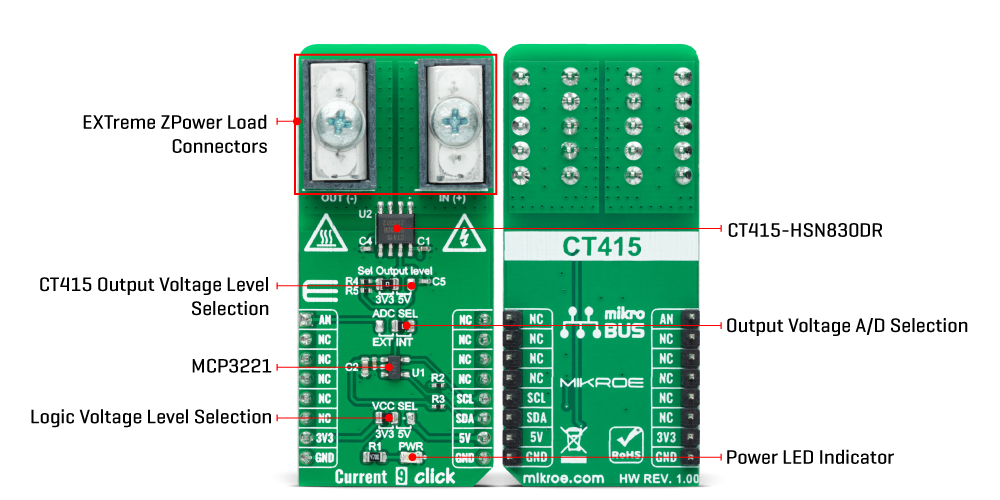

Features overview
Development board
PIC18F57Q43 Curiosity Nano evaluation kit is a cutting-edge hardware platform designed to evaluate microcontrollers within the PIC18-Q43 family. Central to its design is the inclusion of the powerful PIC18F57Q43 microcontroller (MCU), offering advanced functionalities and robust performance. Key features of this evaluation kit include a yellow user LED and a responsive
mechanical user switch, providing seamless interaction and testing. The provision for a 32.768kHz crystal footprint ensures precision timing capabilities. With an onboard debugger boasting a green power and status LED, programming and debugging become intuitive and efficient. Further enhancing its utility is the Virtual serial port (CDC) and a debug GPIO channel (DGI
GPIO), offering extensive connectivity options. Powered via USB, this kit boasts an adjustable target voltage feature facilitated by the MIC5353 LDO regulator, ensuring stable operation with an output voltage ranging from 1.8V to 5.1V, with a maximum output current of 500mA, subject to ambient temperature and voltage constraints.
Microcontroller Overview
MCU Card / MCU

Architecture
PIC
MCU Memory (KB)
128
Silicon Vendor
Microchip
Pin count
48
RAM (Bytes)
8196
You complete me!
Accessories
Curiosity Nano Base for Click boards is a versatile hardware extension platform created to streamline the integration between Curiosity Nano kits and extension boards, tailored explicitly for the mikroBUS™-standardized Click boards and Xplained Pro extension boards. This innovative base board (shield) offers seamless connectivity and expansion possibilities, simplifying experimentation and development. Key features include USB power compatibility from the Curiosity Nano kit, alongside an alternative external power input option for enhanced flexibility. The onboard Li-Ion/LiPo charger and management circuit ensure smooth operation for battery-powered applications, simplifying usage and management. Moreover, the base incorporates a fixed 3.3V PSU dedicated to target and mikroBUS™ power rails, alongside a fixed 5.0V boost converter catering to 5V power rails of mikroBUS™ sockets, providing stable power delivery for various connected devices.
Used MCU Pins
mikroBUS™ mapper
Take a closer look
Click board™ Schematic

Step by step
Project assembly
Software Support
Library Description
This library contains API for Current 9 Click driver.
Key functions:
current9_read_voltageThis function reads the raw ADC value and converts it to a proportional voltage level.current9_read_currentThis function reads the input current level [A] based on @b CURRENT9_NUM_CONVERSIONS of voltage measurements.current9_set_vrefThis function sets the voltage reference for the Current 9 Click driver.
Open Source
Code example
The complete application code and a ready-to-use project are available through the NECTO Studio Package Manager for direct installation in the NECTO Studio. The application code can also be found on the MIKROE GitHub account.
/*!
* @file main.c
* @brief Current 9 Click Example.
*
* # Description
* This example demonstrates the use of Current 9 Click board by reading and
* displaying the input current measurements.
*
* The demo application is composed of two sections :
*
* ## Application Init
* Initializes the driver and logger.
*
* ## Application Task
* Reads the input current measurements and displays the results on the USB UART
* approximately once per second.
*
* @note
* For better accuracy, set the voltage reference by using the @b current9_set_vref function,
* increase the number of conversions by modifying the @b CURRENT9_NUM_CONVERSIONS macro,
* and adjust the @b CURRENT9_ZERO_CURRENT_OFFSET voltage value.
*
* @author Stefan Filipovic
*
*/
#include "board.h"
#include "log.h"
#include "current9.h"
static current9_t current9; /**< Current 9 Click driver object. */
static log_t logger; /**< Logger object. */
void application_init ( void )
{
log_cfg_t log_cfg; /**< Logger config object. */
current9_cfg_t current9_cfg; /**< Click config object. */
/**
* Logger initialization.
* Default baud rate: 115200
* Default log level: LOG_LEVEL_DEBUG
* @note If USB_UART_RX and USB_UART_TX
* are defined as HAL_PIN_NC, you will
* need to define them manually for log to work.
* See @b LOG_MAP_USB_UART macro definition for detailed explanation.
*/
LOG_MAP_USB_UART( log_cfg );
log_init( &logger, &log_cfg );
log_info( &logger, " Application Init " );
// Click initialization.
current9_cfg_setup( ¤t9_cfg );
CURRENT9_MAP_MIKROBUS( current9_cfg, MIKROBUS_1 );
err_t init_flag = current9_init( ¤t9, ¤t9_cfg );
if ( ( ADC_ERROR == init_flag ) || ( I2C_MASTER_ERROR == init_flag ) )
{
log_error( &logger, " Communication init." );
for ( ; ; );
}
log_info( &logger, " Application Task " );
}
void application_task ( void )
{
float current = 0;
if ( CURRENT9_OK == current9_read_current ( ¤t9, ¤t ) )
{
log_printf( &logger, " Current : %.3f[A]\r\n\n", current );
Delay_ms ( 1000 );
}
}
int main ( void )
{
/* Do not remove this line or clock might not be set correctly. */
#ifdef PREINIT_SUPPORTED
preinit();
#endif
application_init( );
for ( ; ; )
{
application_task( );
}
return 0;
}
// ------------------------------------------------------------------------ END
Additional Support
Resources
Category:Current sensor
